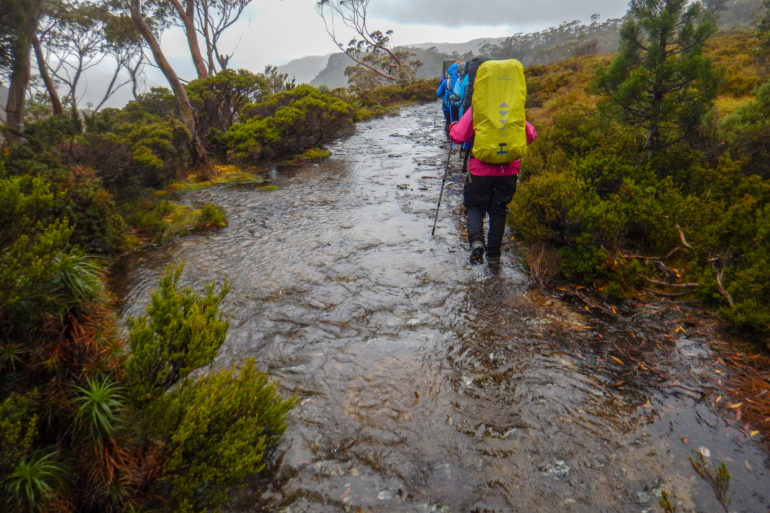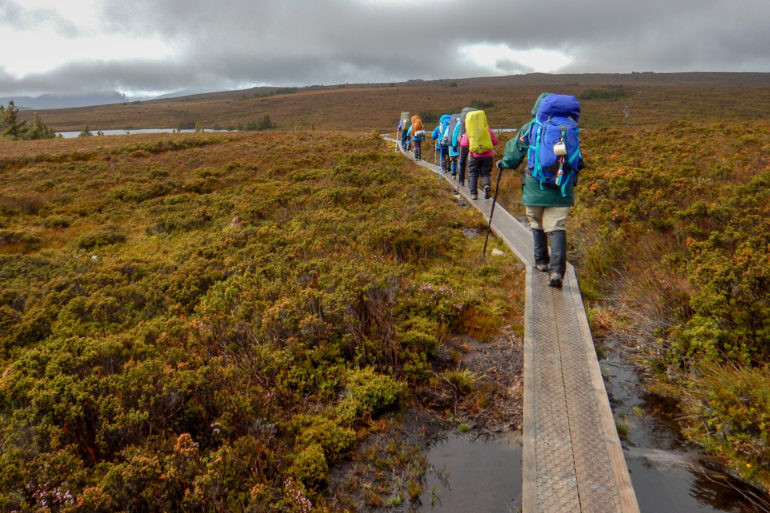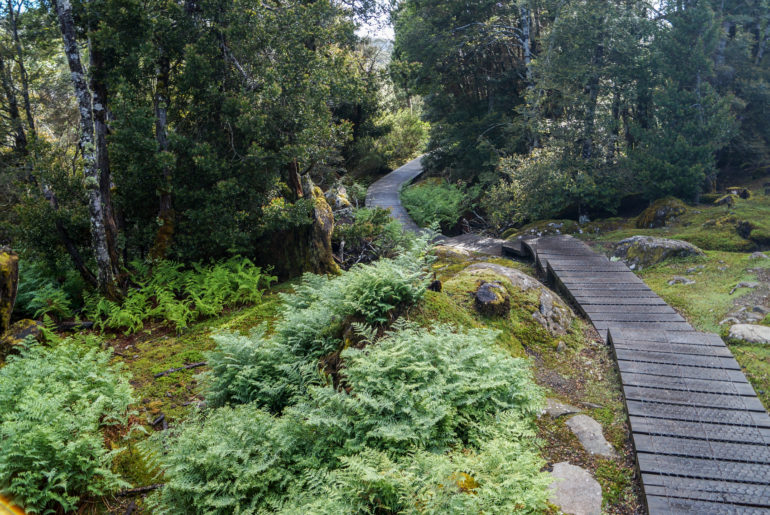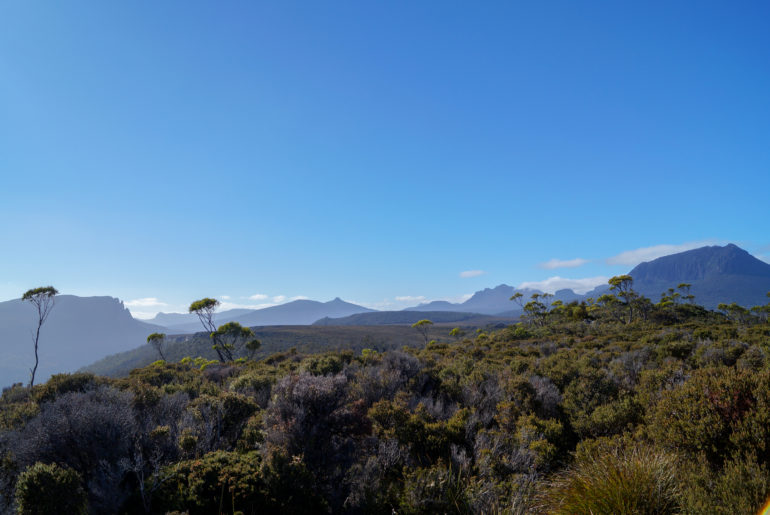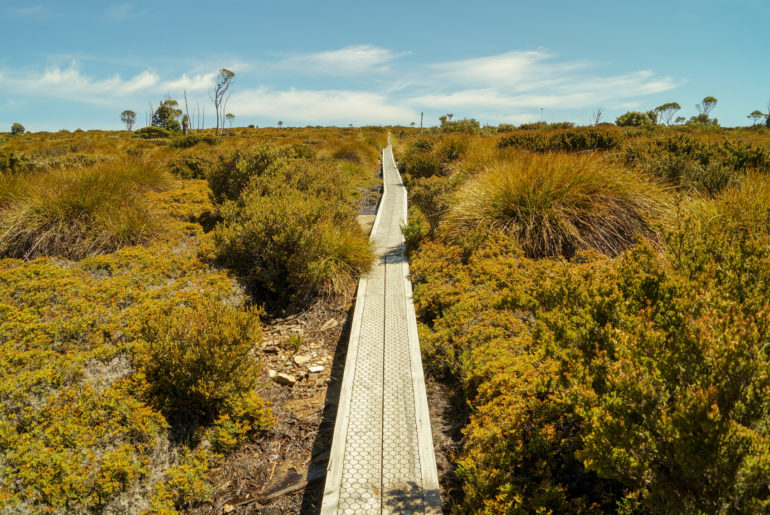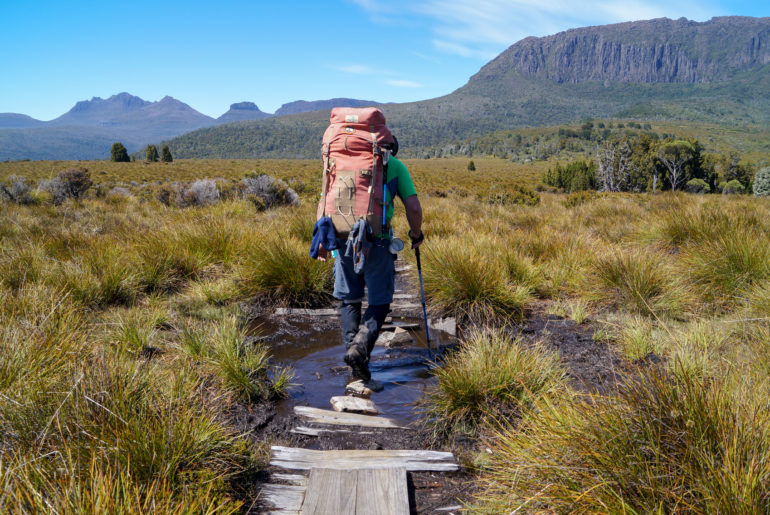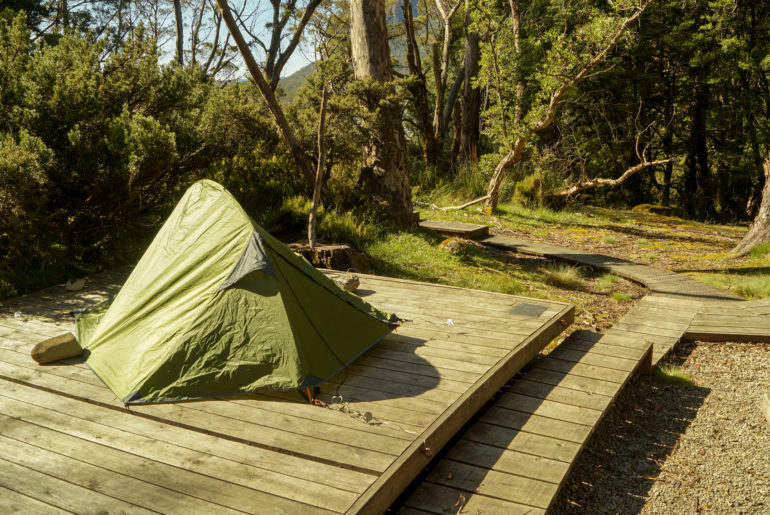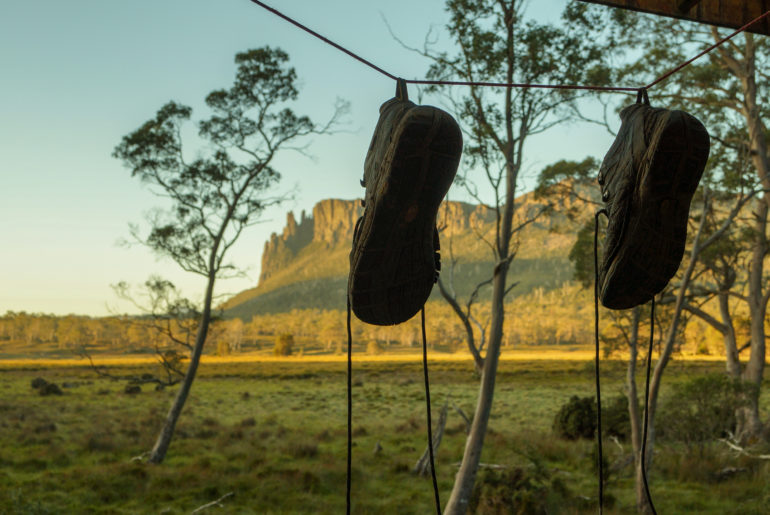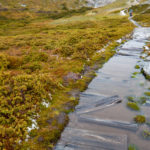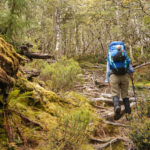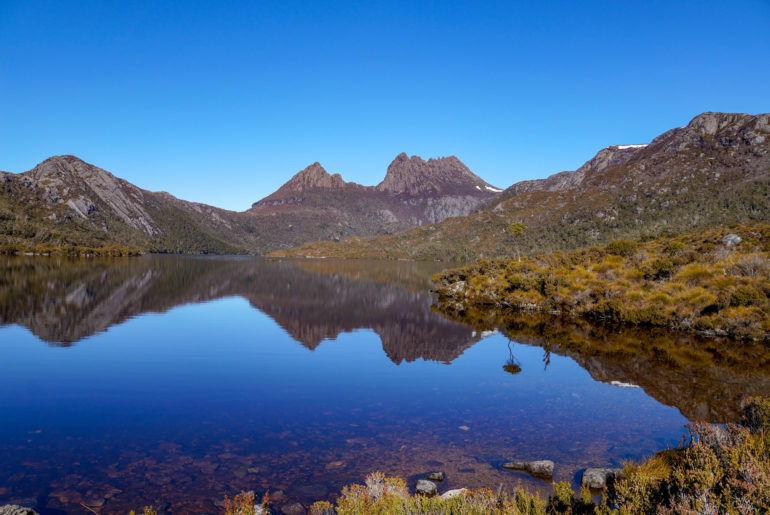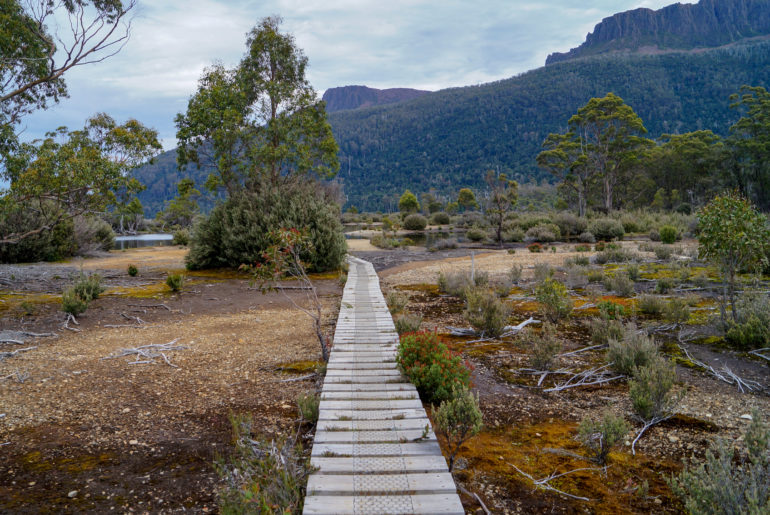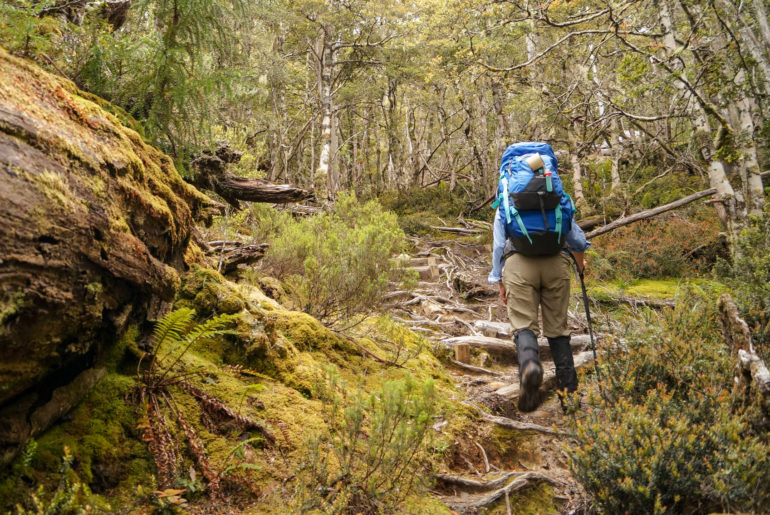I spend a lot of time looking at the ground. If my eyes aren’t on my own boots, they study those of the walker ahead as I watch their careful footsteps through a boggy stretch. Some branches offer a firm footing, others send us sinking and I’m trying to keep my feet dry.
“Don’t forget to look up,” seasoned walkers warned. Their advice has merit.
When the track is tricky and boggy, and a wrong step risks injury or a boot full of mud, it takes effort to remember to take in the scenery. And I didn’t venture into the heart of the Tasmanian wilderness to spend six days staring at my feet.
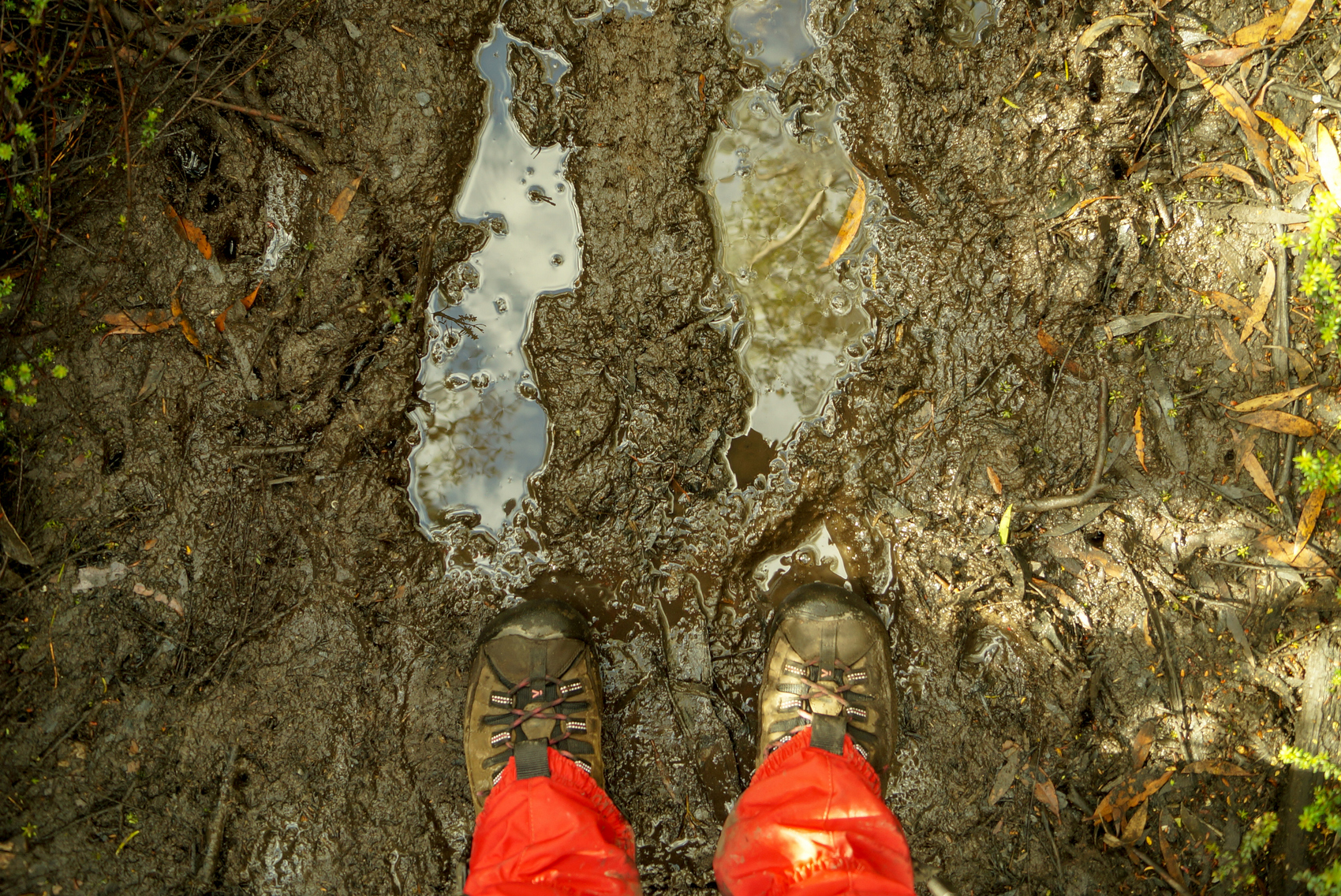
The first day along Tasmania’s Overland Track was a tough initiation and repeating “one down, five to go” brings me no comfort whatsoever. My boots are still wet and my shoulders protest when my pack goes on. The rain stops mid-morning on day two, but the mud serves as a reminder of the poor weather for the rest of the trip.
As the weather improves I can finally appreciate what I’m walking through. Although I’m moving slowly, the landscape and view changes quickly. A twist in the track brings new mountains into view. A gentle climb reveals a smattering of tarns.
Day two feels like a regrouping. My spirits lift, albeit slowly. My journey might not have started as expected, but what adventure goes to plan?
On the edge of Lake Windermere an Irishman is getting dressed back into his hiking clothes. He’s just returned from an “invigorating” swim to a small island about 100 metres from shore. There’s a book and a pen on the island, a makeshift honour board for those crazy enough to attempt the stunt. It’s a list I won’t be adding my name to.
The Irishman and his wife are part of the guided tour. The tours are certainly a more expensive way to experience the Overland Track, but definitely more comfortable. Walkers on the tours carry only a day pack with their personal items.
All bedding is supplied at the private huts, which also offer electricity and showers (an absolute luxury at the end of day one, let alone after day three or five), and they will enjoy a three-course meal each night. With wine! I feel slightly envious at times, but being entirely self-sufficient as I trek through the wilderness adds to the significance of this adventure.
I am one of 8000 people walking the Overland Track this year, a number that’s risen steadily from the 1400 people who completed the walk in 1970. But the history of the track goes back much further. The Overland Track, as we know it now, opened in 1931. Prospectors, stockmen and hunters forged tracks and built huts in the area in the early 1900s, which Bert Nichols used when guiding the first walking party on the journey.
At Windermere Hut the walkers carry out their post-walk routine – clothes and shoes hog the gas heater, food supplies cover the benches, sleeping mats and bags claim spots on the bunks and water boils on little gas cookers for a cuppa. I pass the time chatting to the ranger and reading the comments in the walkers’ log book. I am comforted slightly by the remarks of snow and foul weather from fellow summer walkers in other years. I scowl at those celebrating the sunshine.
The ranger, here on an eight-day stint before walking out to enjoy his days off, speaks candidly about the issues that come with the Overland Track’s growing popularity. Rescues are frustratingly common – something I became all too aware of as a journalist for the local paper. Too many walkers are significantly unprepared for the hike.
“People think it’s all boardwalk all the way,” the ranger says, lamenting walkers who tackle the journey in jeans or street shoes. While the upgrades to the track mean it’s not as challenging as it has been, the conditions can be unforgiving and change in heartbeat. Inexperienced walkers take that for granted and can wind up in trouble. Then there’s the walkers who summon emergency rescue services because they’re tired. Yes, really.
The other challenge is the balance between preserving the environment and making it accessible. Track maintenance is carried out each year and improvements are ongoing. More duckboard is being laid to reduce the impact of the walkers on the ground, but in doing so the track becomes easier and therefore attractive to more people.
And with more people comes more impact. Although walkers are told to carry out all their rubbish under the Leave No Trace principle, a huge amount of waste is still removed from the track and around the huts each season.
There is a fine line between providing the infrastructure for people to experience this part of the wilderness and maintaining the pristine condition that makes being here so special.
At some point in the night a fellow walker drags the packs into the hut and out of the reach of scavenging possums. How they hear the possums over the chorus of snores is beyond me. It’s early when I walk back down to the lake, which is free of swimming Irishmen this time.
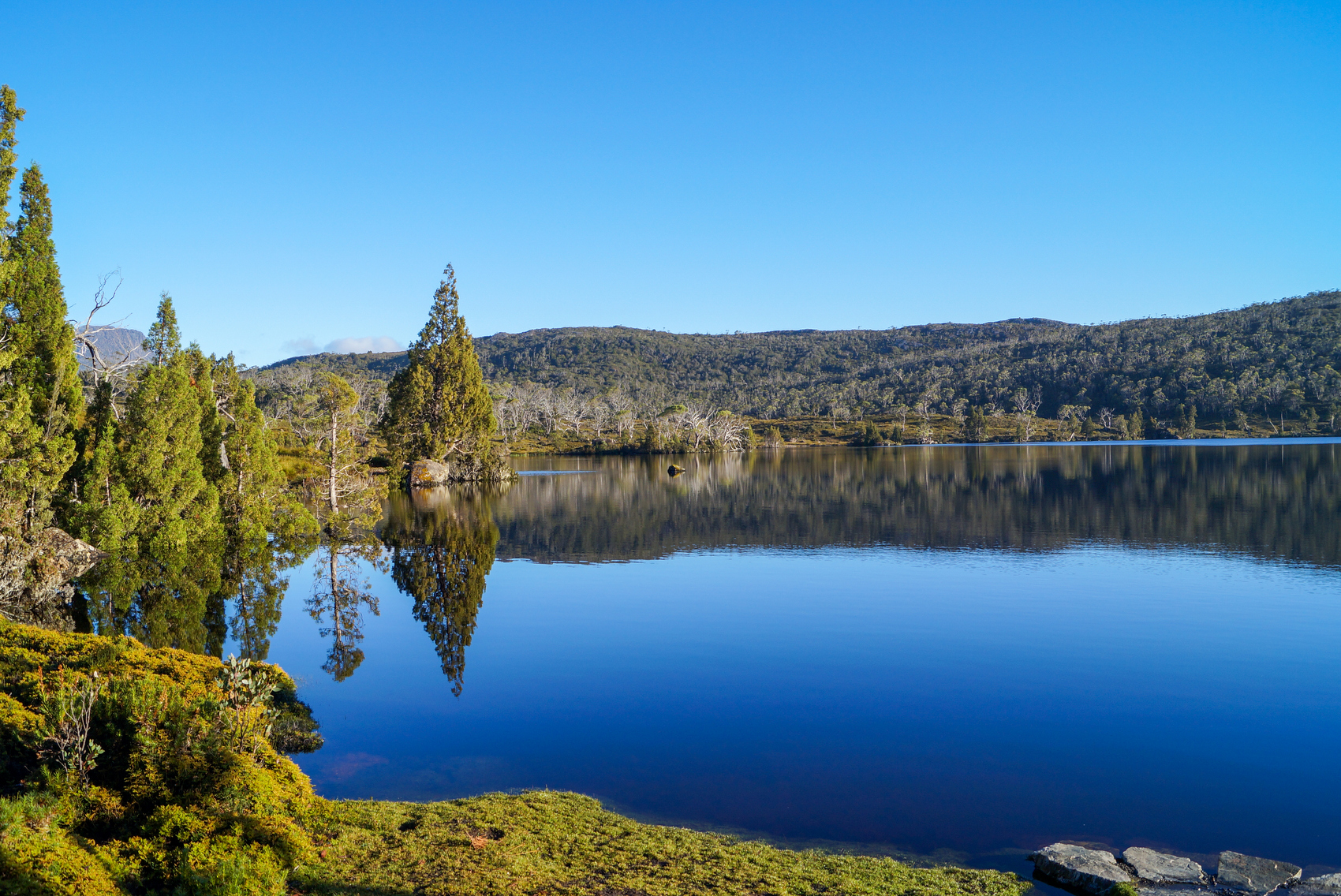
Aside from a tuft of cloud over the top of Barn Bluff, the clouds are clear for the first time in days. With the sun yet to work its magic, the track is still a little icy, as is the air. Breakfast can wait.
This is what I had been waiting for. The stillness. The quiet. The scenery. And the feeling of being somewhere very, very special.
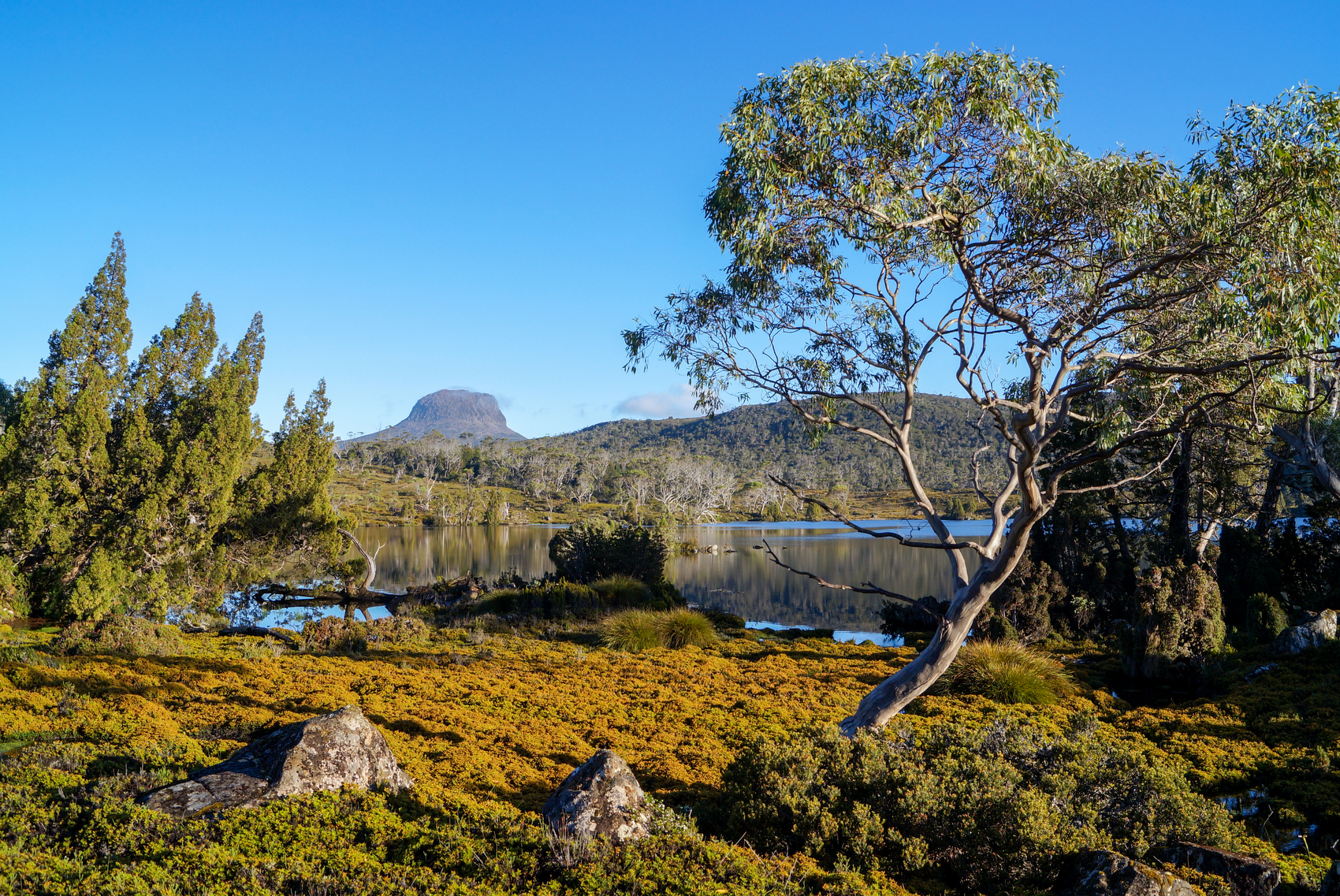
With my pack back on my shoulders and my feet laced into my well-moulded boots, I set off from Winderemere Hut alone. Some of my group of 11 is ahead, the rest have yet to leave.
I enjoy the solitude as I stroll through forests and rise up to plateaus. Today, day three, is the longest on the track – I have about 17 kilometres to cover – but I’m in no hurry.
I spot Pelion East and Mount Ossa in the distance early. It stirs something inside me – an excitement for what’s to come. Then Pelion West and Mount Oakleigh come into view. Some of these names are new to me at the time, but by the end of the day their outline on the horizon is beautifully etched in my memory.
I see walkers ahead and slow down. By the time I climb to the plateau and see some of Tasmania’s highest peaks before me, I am completely alone.
Me and the mountains.
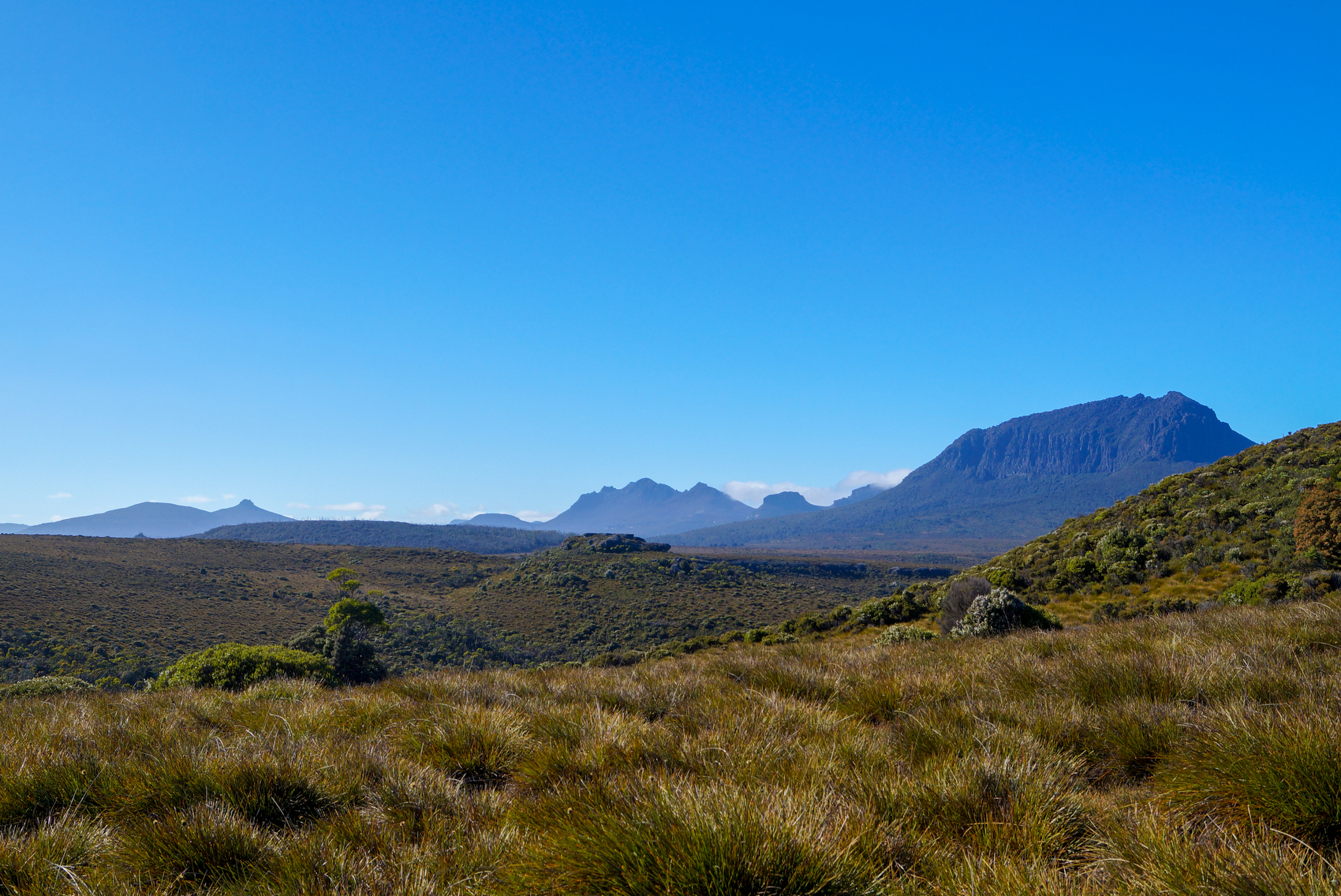
It is a sensational feeling. Not just witnessing something so spectacular, but knowing what it takes to get here to see this. The only way to have this view is after a long, tough walk. (Unless you’re one of those insane people who do the Cradle Mountain Run and cover the entire Overland Track in a matter of hours.)
I have not lucked upon these sights. I have earned it.
The scenery makes a long day of walking more enjoyable and certainly more tolerable. I hate to think what covering this distance would have been like if the bad weather had continued. The track is still muddy in a lot of sections, particularly where the trees have blocked the sun from drying it even a little bit.
We walk on gravel, duckboard and mud.
Through flooded sections we use logs and branches as steps through the water, but a 20-kilogram pack on my back doesn’t make it easy to balance. Sometimes it is hard to take my eyes off my feet, but I remind myself of the advice I was given and lift my head to take in my surroundings, even for a moment, before studying the path ahead.
The landscape is always changing. As we walk into a small forest after visiting the Forth Valley Lookout the odd myrtle oranges are easy to spot. When we emerge from the trees the delicate purple petals of fairies aprons stick up in the mud and central lemon boronia plants hang over the track. Not long after filling my mug from a waterfall, we spot an echidna trying to bury under a log.
I take photos in every direction, which will end up being my favourite from the trip. The crisp blue skies and plethora of mountains are ridiculously photogenic.
I take any opportunity to sit down, or even better, take off my pack. A minute or so without it is bliss. I keep fit, but this is tough going. Hiking downhill is always hard on my knees, but having my pack weighing down on me makes it even less enjoyable. And going up, well, that’s not much fun either.
My pack, which should feel lighter as I eat more of my food supply, feels heavier than ever as my body tires. There are many times when I swing my pack on and wonder how I will carry the thing for another eight hours. I regularly adjust the belt tighter around my hips and waist, and run my hands under the straps on my shoulders to relieve some pressure.
At times I catch up with other members of my group or they catch up to me. We’re mostly family, although a lot of the group includes my dad’s cousins from New Zealand, some of whom I’d never met. Free of distractions and interruptions, the long days on the trail and nights spent playing cards in the hut are chances to get to know each other that we might not ever have had otherwise.
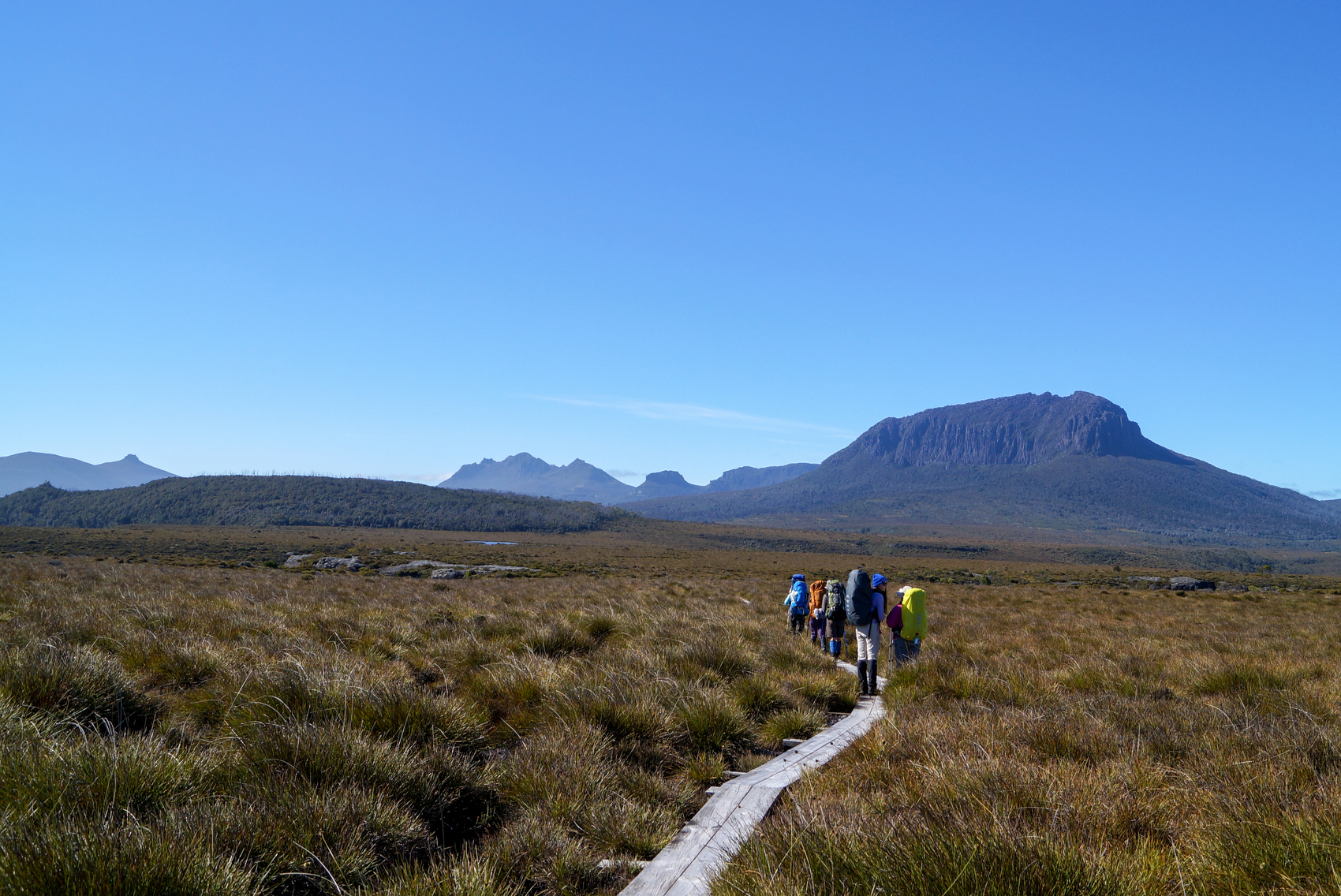
When I reach New Pelion Hut I am buggered.
This is a bigger hut than the others as it also caters for walkers who come in along the Arm River Track or across Lees Paddocks and use it as a base to climb the nearby peaks, including Tasmania’s highest mountain, Mount Ossa. Many of the Overland Track walkers look familiar. The German couple, who again left first thing this morning, are set up in the hut long before I show up.
There’s also two men and their sons who I recognise but haven’t spoken to until now. The boys, aged nine and 10, have done a few walks of three or four nights, but nothing this long before. They will spend two nights at New Pelion and enjoy a rest day tomorrow so I won’t see them again. The boys are pretty energetic despite the big day of walking. My feet ache just walking around the hut in my socks.
Not far from Douglas Creek and surrounded by eucalypts I set up my tent for the first time and go to sleep while wildlife scurry over the camping platform and into the bushes.




